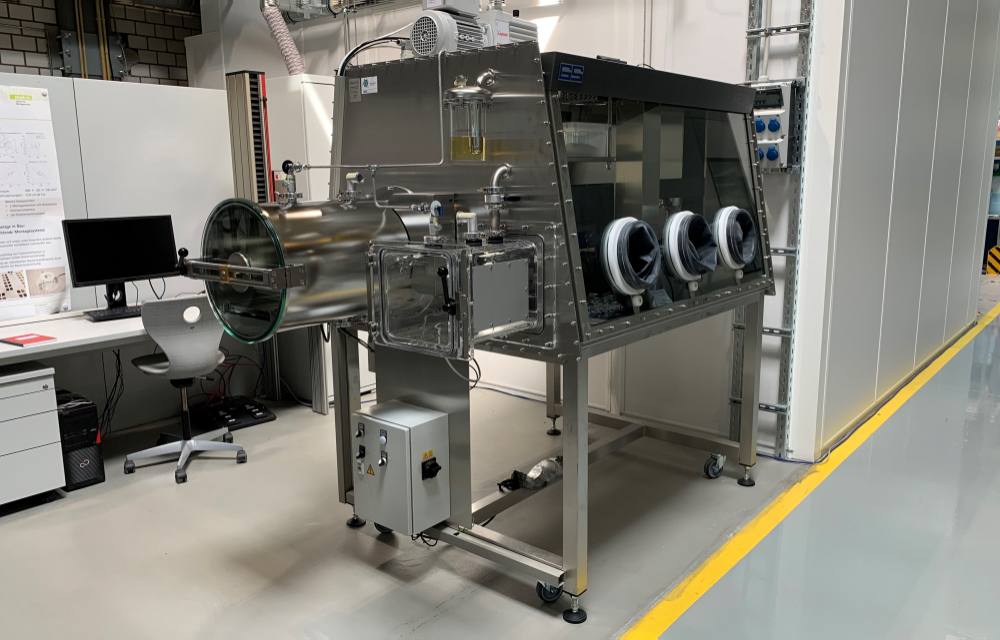In many manufacturing areas, the presence of oxygen plays a decisive role in the quality of the results. For this reason, scientists in Collaborative Research Center 1368 “Oxygen-Free Production” are investigating a wide range of processes and active zones in an oxygen-free atmosphere to develop future-proof production techniques and manufacturing processes.
The Institute of Assembly Technology (match) is focusing on adhesive bonding technology in subproject B04. Adhesive bonding has many advantages, such as the ability to join heterogeneous joining partners or sensitive components. In addition, adhesive bonding enables a weight reduction compared to other joining methods such as screwing. On the other hand, process control is complex and time-consuming. To counteract these challenges, the scientists of the match are investigating adhesive bonding in an oxygen-free environment.
Specifically slowing down or accelerating adhesive curing
First, adhesives whose setting reactions are dependent on oxygen or moisture are investigated. Cyanoacrylates, which are better known as instant adhesives, cure by initiation reaction with OH–ions. Their absence in an oxygen-free environment extends the processing time and allows the joining partners to be positioned more precisely. Then the adhesive is selectively cured by the addition of moisture.
The curing process of anaerobic adhesives takes place in the absence of oxygen. Contact with metal ions releases radicals that initiate polymerization of the adhesive. Possible advantages of bonding in the oxygen-free environment here are a shorter curing time and a higher adhesive layer thickness.
Bonding of pure metals without oxide layer
In practice, most bonded joints fail due to detachment of the adhesive layer from the joining part. This breakage is caused partly by unsuitable adhesive-material pairings and partly by inadequate pretreatment of the surfaces. In standard atmospheres, metal surfaces are practically always bonded with an intermediate oxide layer due to chemical activity. These layers are usually detrimental to the adhesive properties of a material.
In an oxygen-free environment, the formation of a monolayer of metal oxide is slowed down to such an extent that bonding without an intermediate oxide layer is theoretically possible. These direct bonds offer the potential to use joining partner-adhesive combinations that were previously impossible. They also enable higher strengths, thinner layer thicknesses, faster reaction times, longer pot lives and much more.
Glove box as oxygen-free process environment
Since there is sufficient residual oxygen in all conventionally used inert gas atmospheres to support the oxidation of metals, a pure inert gas atmosphere is not enough for the investigations. Therefore, a small amount of monosilane is added to the inert gas atmosphere of grade 5.0 argon. Monosilane is a very reactive gas. Both the residual oxygen and any water still present in the environment react quickly and completely. This reduces the partial pressure of oxygen to 10-23 bar, which corresponds to an atmosphere equivalent to an extremely high vacuum (XHV).
To realize such an experimental environment, the match scientists use a custom-designed glove box. The glove box has a vacuum antechamber for transfer into and out of the glove box atmosphere. An additional transparent PMMA antechamber is available for experiments that require a variation of the environment through the addition of oxygen or moisture.
Destructive test methods for analyzing the technical properties
Various analytical techniques are used to gain knowledge about the properties of adhesives on oxidized and oxide-free joining partners. The technical properties of the bondings, such as strength, are determined by destructive test methods directly in an oxygen-free environment.
To understand relationships between measured technical properties and adhesion at the molecular level, the Institute of Assembly Technology cooperates with the Clausthal Center for Materials Research (CZM). There, surface physics methods such as X-ray photoelectron spectroscopy or atomic force microscopy investigate bonding at the interface between adhesive and joining partner and the curing of the adhesive at the molecular level.
The long-term perspective of adhesive-based assembly processes
Initial investigations have shown that bonding in XHV-adequate atmospheres offers new possibilities for flexible process control. To deepen the process understanding, the scientists will extend the examinations to other joining materials and adhesives. The match and the CZM transfer the knowledge gained into a model that supports the design of bonded joints and processes in oxygen-free atmospheres. In the long term, the aim is to develop a comprehensive simulation-based model that will enable the creation of oxide-free bonded joints largely independent of material and geometry.
Further information on the Collaborative Research Center 1368 “Oxygen-free production” is available at www.sfb1368.uni-hannover.de/en.

